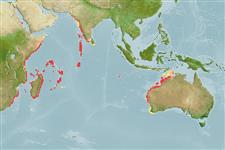>
Eupercaria/misc (Various families in series Eupercaria) >
Labridae (Wrasses) > Corinae
Etymology: Halichoeres: Greek, als, alis = salt + Greek, choiros = pig (Ref. 45335).
More on authors: Randall & Smith.
Environment: milieu / climate zone / profondeur / distribution range
Écologie
marin récifal; profondeur 15 - 56 m (Ref. 9710). Tropical
Western Indian Ocean: Sodwana Bay, South Africa (Ref. 11228), Maldives and Mauritius.
Taille / Poids / Âge
Maturité: Lm ? range ? - ? cm
Max length : 9.5 cm TL mâle / non sexé; (Ref. 90102)
Description synthétique
Clés d'identification | Morphologie | Morphométrie
Épines dorsales (Total) : 21; Rayons mous dorsaux (Total) : 12; Épines anales: 15; Rayons mous anaux: 12. Almost white with some black spots or lines on the head (Ref. 48636).
Body shape (shape guide): fusiform / normal.
Found on sandy areas of deep lagoon and seaward reefs (Ref. 9710), usually along deep drop-offs with large caves, rich with invertebrate growth in depths over 20 m. Occurs in small groups of females, usually a male swimming nearby (Ref. 48636). May be found solitary (Ref. 90102).
Life cycle and mating behavior
Maturité | Reproduction | Frai | Œufs | Fécondité | Larves
Distinct pairing during breeding (Ref. 205).
Lieske, E. and R. Myers, 1994. Collins Pocket Guide. Coral reef fishes. Indo-Pacific & Caribbean including the Red Sea. Haper Collins Publishers, 400 p. (Ref. 9710)
Statut dans la liste rouge de l'IUCN (Ref. 130435: Version 2025-1)
Menace pour l'homme
Harmless
Utilisations par l'homme
Outils
Articles particuliers
Télécharger en XML
Sources Internet
Estimates based on models
Preferred temperature (Réf.
123201): 22.8 - 28.4, mean 26.8 °C (based on 92 cells).
Phylogenetic diversity index (Réf.
82804): PD
50 = 0.5000 [Uniqueness, from 0.5 = low to 2.0 = high].
Bayesian length-weight: a=0.00977 (0.00468 - 0.02039), b=3.09 (2.92 - 3.26), in cm total length, based on LWR estimates for this Genus-body shape (Ref.
93245).
Niveau trophique (Réf.
69278): 3.3 ±0.5 se; based on size and trophs of closest relatives
Résilience (Réf.
120179): Haut, temps minimum de doublement de population inférieur à 15 mois (Preliminary K or Fecundity.).
Fishing Vulnerability (Ref.
59153): Low vulnerability (10 of 100).
🛈
Nutrients (Ref.
124155): Calcium = 116 [68, 210] mg/100g; Iron = 0.852 [0.491, 1.596] mg/100g; Protein = 18.3 [15.5, 20.5] %; Omega3 = 0.179 [0.108, 0.290] g/100g; Selenium = 26.1 [14.7, 47.9] μg/100g; VitaminA = 158 [48, 610] μg/100g; Zinc = 2.02 [1.35, 3.19] mg/100g (wet weight);
